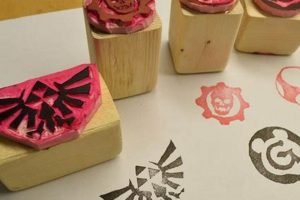The creation of homemade, non-Newtonian fluids, often referred to by a particular descriptive term, involves combining a starch, typically cornstarch, with water. The resultant mixture exhibits properties of both a liquid and a solid, depending on the applied force. Applying pressure causes the substance to thicken and behave like a solid, while allowing it to rest results in a return to a more liquid consistency. This characteristic makes it an engaging substance for scientific demonstrations and tactile play.
The ability to easily synthesize this material offers educational benefits, allowing for hands-on exploration of physics concepts such as viscosity and states of matter. The simple composition and availability of ingredients contribute to its accessibility, making it a cost-effective option for both educational institutions and home experimentation. Furthermore, its non-toxic nature, when prepared with standard kitchen ingredients, provides a safe medium for interactive learning experiences.
Subsequent sections will explore the precise ratios for optimal consistency, variations in preparation techniques, and potential applications of this fascinating fluid in various contexts, emphasizing its role in promoting scientific understanding and sensory exploration.
Preparation Guidance
The following guidelines are intended to optimize the creation and utilization of a cornstarch and water mixture. Attention to these details can enhance the experiential and educational value derived from this material.
Tip 1: Precise Measurement: A ratio of approximately 1.5 to 2 parts cornstarch to 1 part water is generally recommended. Incremental adjustments may be required based on environmental humidity and cornstarch density. Accurate measurement is critical for achieving the desired non-Newtonian behavior.
Tip 2: Gradual Water Incorporation: Introduce water slowly and methodically into the cornstarch, mixing thoroughly. Avoid adding water too rapidly, as this can lead to clumping and an uneven consistency. A gradual approach promotes uniform hydration of the cornstarch particles.
Tip 3: Agitation Considerations: Initial mixing may require considerable force due to the thickening nature of the mixture. Utilize a sturdy mixing utensil, and consider dividing the cornstarch into smaller batches for easier manipulation during the early stages of preparation.
Tip 4: Colorant Integration: If desired, food coloring should be added to the water prior to its incorporation into the cornstarch. This ensures even distribution of color throughout the mixture and prevents localized concentrations of dye.
Tip 5: Storage Protocols: When not in use, the mixture should be stored in an airtight container to prevent evaporation and maintain its desired consistency. Prolonged exposure to air can result in drying and hardening of the material.
Tip 6: Clean-Up Procedures: Thoroughly rinse all utensils and work surfaces immediately after use. Dried cornstarch can be difficult to remove. Avoid pouring excess mixture down drains, as it can solidify and cause blockages. Dispose of excess material responsibly, preferably in a solid waste receptacle.
Adherence to these guidelines can facilitate the successful creation and maintenance of a homogenous, non-Newtonian substance, maximizing its utility for educational and recreational purposes.
The subsequent section will delve into advanced applications of the created substance and explore its utility in specific scientific demonstrations and sensory activities.
1. Ratio Optimization
Ratio optimization is a critical determinant in the success of a homemade non-Newtonian fluid preparation. The fluid’s characteristic behavior, exhibiting both liquid and solid properties under varying degrees of stress, hinges on the precise proportion of starch to water. An insufficient starch concentration results in a mixture that primarily resembles a liquid, failing to exhibit the desired solidification under pressure. Conversely, an excessive starch concentration creates a dry, crumbly substance, equally incapable of demonstrating the intended fluid dynamics. For example, using a 1:1 ratio of cornstarch to water may yield a fluid that is too thin and lacks the expected resistance to force. Conversely, a 3:1 ratio might create an unworkable solid mass.
The optimal ratio typically falls within a range, often approximated as 1.5 to 2 parts cornstarch to 1 part water, by volume. This range accommodates variations in starch density, water purity, and environmental humidity. The adjustment within this range must be iterative, with small increments of either starch or water added until the mixture exhibits the desired behavior: flowing freely when undisturbed but offering significant resistance to rapid deformation. The ability to achieve this balance allows for effective demonstration of concepts such as shear thickening and the distinction between Newtonian and non-Newtonian fluids in educational settings.
In summary, ratio optimization is not merely a step in the preparation process but a fundamental requirement for realizing the intended properties of a homemade non-Newtonian fluid. Failure to attend to this aspect compromises the fluid’s functionality and, consequently, diminishes its utility for scientific exploration or recreational engagement. Achieving the correct ratio necessitates careful measurement, incremental adjustments, and observation of the mixture’s response to applied force. This process serves as a practical lesson in the importance of precision in scientific endeavors.
2. Starch Type
The selection of starch fundamentally influences the characteristics of a homemade non-Newtonian fluid. Different starches, such as cornstarch, potato starch, tapioca starch, and arrowroot starch, possess varying granule sizes and amylose-to-amylopectin ratios. These variations directly impact the fluid’s viscosity, texture, and overall non-Newtonian behavior. Cornstarch, owing to its ready availability and suitable granule size, is commonly employed. However, alternative starches can be used to achieve distinct tactile or visual effects. For example, potato starch, with its larger granule size, may produce a slightly coarser texture compared to the smoother consistency resulting from cornstarch.
The amylose-to-amylopectin ratio within the starch granules also plays a significant role. Amylose, a linear glucose polymer, contributes to gel formation and viscosity. Amylopectin, a branched glucose polymer, influences the texture and stability of the fluid. Starches with higher amylopectin content tend to produce mixtures that are more resistant to syneresis (water separation). Thus, altering the starch type allows for a degree of control over the final product’s rheological properties. Moreover, considerations of allergenicity may dictate starch selection. For instance, tapioca starch, derived from the cassava root, presents a gluten-free altern
ative suitable for individuals with celiac disease or gluten sensitivities, while wheat starch would be inappropriate.
In conclusion, the choice of starch type is a critical parameter in the formulation. While cornstarch provides a reliable and readily accessible option, alternative starches offer opportunities to fine-tune the fluid’s properties based on desired texture, viscosity, allergenicity, and aesthetic considerations. A comprehensive understanding of starch characteristics enables a more informed and customized approach to fluid preparation, maximizing its utility for educational demonstrations or sensory exploration. Subsequent investigation may explore the influence of water quality on these mixtures.
3. Water Quality
Water quality exerts a demonstrable influence on the consistency and behavior of homemade non-Newtonian fluids. Impurities, dissolved minerals, and pH levels present in water sources can alter the hydration of starch molecules, thereby affecting the fluid’s viscosity and shear-thickening properties. Hard water, characterized by high concentrations of calcium and magnesium ions, may interact with the starch, potentially inhibiting complete hydration and resulting in a less homogenous mixture. Conversely, excessively soft water may lack the necessary ionic strength for optimal starch suspension, leading to instability and phase separation over time. The presence of organic contaminants or excessive chlorine levels can similarly interfere with starch particle interaction, compromising the fluid’s intended functionality. For instance, using tap water with elevated chlorine levels may subtly alter the starch’s chemical structure, affecting its gelatinization properties.
Distilled or deionized water represents a controlled baseline for fluid preparation, mitigating the confounding effects of variable water quality. These purified water sources ensure that any observed variations in the fluid’s behavior are attributable to other factors, such as starch type or mixing technique, rather than inconsistencies in the water itself. However, the use of distilled water may not always be necessary or practical. In many situations, filtered tap water can provide an adequate compromise between purity and convenience. Filtration removes particulate matter and some dissolved minerals, improving water quality without the expense or complexity of distillation. The selection of water source should therefore be guided by a balance of experimental control, resource availability, and intended application. For example, in a classroom setting where precise replicability is essential, distilled water may be preferred. In a home setting for recreational use, filtered tap water may suffice.
In conclusion, water quality is not a negligible factor in the formulation of these fluids. While the use of distilled water provides the greatest assurance of consistency, practical considerations often dictate the use of alternative water sources. A thorough understanding of local water characteristics and their potential impact on starch hydration is essential for achieving predictable and reliable results. The mitigation of water quality variables contributes to the robustness and educational value of the fluid, ensuring its effectiveness in demonstrating scientific principles or providing engaging sensory experiences. Consideration of water quality thus extends beyond mere ingredient selection to encompass a broader appreciation of the factors governing material properties.
4. Mixing Technique
The efficacy of any non-Newtonian fluid hinges significantly on the mixing technique employed during its preparation. A suboptimal mixing process can result in an uneven distribution of starch particles within the water matrix, leading to inconsistencies in the fluid’s characteristic shear-thickening behavior. Achieving a homogenous mixture requires careful attention to the rate, method, and duration of agitation.
- Initial Incorporation of Water
The gradual addition of water to starch is paramount. A rapid influx of water can induce clumping, as the starch particles agglomerate before they can be individually hydrated. This necessitates a slower, more controlled introduction of water, allowing each particle to interact uniformly with the liquid phase. Insufficient initial hydration leads to persistent clumps, while excessive water addition negates the desired consistency. Manual mixing, particularly with a spatula or whisk, permits tactile feedback on the mixture’s texture, enabling adjustments in water addition as needed.
- Agitation Intensity and Duration
The intensity and duration of mixing are crucial to achieving a homogenous suspension. Insufficient agitation leaves pockets of dry starch, compromising the fluid’s uniformity. Over-mixing, while less problematic, can introduce air bubbles, altering the fluid’s visual appeal and potentially its rheological properties. The optimal mixing duration depends on the batch size and the equipment used. Small batches mixed manually require more prolonged agitation compared to larger batches processed with mechanical mixers. The goal is a uniform, glossy texture free of visible clumps.
- De-Aeration Considerations
Air bubbles, introduced during mixing, can impact the fluid’s optical clarity and potentially alter its shear-thickening response. While not always necessary, de-aeration can enhance the fluid’s visual appeal and ensure more consistent behavior. Allowing the mixture to rest for a period after mixing permits air bubbles to dissipate naturally. Alternatively, gentle tapping of the container can facilitate bubble removal. Vacuum de-aeration, a more advanced technique, is typically unnecessary for small-scale preparations but may be beneficial for large-volume applications requiring precise control of rheological properties.
- Tool Selection Impact
The selection of mixing tools can influence the final product’s characteristics. Spatulas, whisks, and electric mixers each impart different shear forces to the mixture, affecting the starch’s dispersion. A spatula allows for precise, controlled mixing, ideal for small batches and visual assessment of texture. A whisk provides more efficient mixing for larger quantities. Electric mixers, while convenient, can introduce excessive shear, potentially disrupting the starch granules and altering the fluid’s viscosity. The choice of tool should align with the batch size, desired level of control, and potential impact on the fluid’s rheological properties.
In conclusion, the mixing technique is not a mere procedural step but an integral determinant of the quality and efficacy of the resulting non-Newtonian fluid. Meticulous control over water incorporation, agitation intensity, de-aeration, and tool selection contributes to a homogenous, visually appealing, and predictably behaving mixture, maximizing its utility for educational demonstrations, sensory exploration, or scientific experimentation. A well-executed mixing process translates directly into a more robust and reliable manifestation of the fluid’s characteristic non-Newtonian properties.
5. Storage Conditions
The longevity and utility of a homemade, starch-based n
on-Newtonian fluid are directly influenced by its storage environment. Improper storage conditions can lead to alterations in the fluid’s consistency, rendering it less effective for its intended purpose, whether that be educational demonstration or sensory play. The primary concern is the prevention of water evaporation. Exposure to air promotes desiccation, causing the mixture to solidify and lose its fluid properties. This transformation not only detracts from the material’s intended behavior but also necessitates remaking the substance, incurring additional resource expenditure.
The ideal storage solution involves an airtight container. This minimizes air exposure, thereby slowing the rate of evaporation. Furthermore, the container should be composed of a non-reactive material, such as polypropylene or high-density polyethylene, to prevent leaching or degradation of the fluid’s components. Ambient temperature also plays a role. Elevated temperatures accelerate evaporation, whereas excessively low temperatures can induce phase separation, causing the starch to settle and the water to separate. Maintaining a moderate, stable temperature helps preserve the fluid’s homogeneity. Real-world examples illustrate this point: A container left open overnight will typically result in a hardened, unusable mass, while a sealed container stored in a cool pantry can maintain its consistency for several days or even weeks.
In summary, appropriate storage conditions are not merely an afterthought but an integral component of the overall process. Proper storage ensures the non-Newtonian fluid remains viable for repeated use, maximizing its educational or recreational value. Overlooking this aspect undermines the effort invested in the initial preparation. The understanding of this link between storage and fluid integrity reinforces the importance of comprehensive planning in any experimental or creative endeavor. Addressing potential challenges, such as limited airtight container availability, highlights the need for resourceful adaptation, emphasizing the broader theme of practicality and resourcefulness in scientific exploration.
Frequently Asked Questions
This section addresses common inquiries regarding the creation and utilization of a starch-based, non-Newtonian fluid, clarifying potential ambiguities and providing practical guidance.
Question 1: What is the approximate shelf life of a homemade non-Newtonian fluid?
The longevity of the fluid is contingent upon storage conditions. When stored in an airtight container at a stable temperature, the fluid can typically maintain its desired consistency for several days to several weeks. Visual inspection for signs of drying or phase separation is recommended prior to each use. Addition of small amounts of water can sometimes restore the fluid’s consistency; however, significant degradation necessitates replacement.
Question 2: Can different types of starch be combined to create the fluid?
While the fluid is typically prepared with a single starch type, combining different starches is possible. The resulting properties of the fluid will reflect a composite of the individual starches’ characteristics, such as granule size and amylose/amylopectin ratio. Experimentation with starch combinations can yield novel textures; however, consistent results may be more challenging to achieve.
Question 3: Is there a risk of staining associated with the fluid, particularly when using food coloring?
Food coloring can potentially stain porous surfaces. To mitigate this risk, it is advisable to use washable food coloring and to protect work surfaces with a non-porous barrier, such as plastic sheeting. Prompt cleanup of any spills is also recommended. Testing the food coloring on an inconspicuous area is advisable before widespread use.
Question 4: How does temperature affect the fluid’s behavior?
Temperature influences the viscosity of the fluid. Elevated temperatures generally decrease viscosity, while lower temperatures increase viscosity. Extreme temperatures can disrupt the starch-water interaction, leading to irreversible changes in the fluid’s properties. Maintaining the fluid at room temperature is generally recommended for optimal performance.
Question 5: What safety precautions should be observed when working with the fluid?
While the fluid is generally considered non-toxic when prepared with common kitchen ingredients, it is advisable to avoid ingestion. The fluid should be used under adult supervision, particularly when children are involved. Individuals with starch allergies should exercise caution. Proper handwashing after handling the fluid is recommended.
Question 6: How does humidity affect the optimal starch-to-water ratio?
Higher ambient humidity levels can slightly reduce the amount of water needed to achieve the desired fluid consistency. In humid environments, starting with a slightly higher starch-to-water ratio and gradually adding water as needed can help prevent the mixture from becoming too thin.
In summary, the successful preparation and utilization of a starch-based, non-Newtonian fluid necessitates attention to storage, material properties, safety, and environmental factors. Adherence to these considerations enhances the educational and recreational value of the fluid.
Subsequent sections will explore advanced applications of this novel substance and consider its utility in various scientific demonstrations and sensory engagement exercises.
Conclusion
The preceding exposition has elucidated critical factors relevant to the creation and manipulation of what is commonly termed a “diy goop recipe,” focusing on the non-Newtonian fluid derived from starch and water. From precise ratio optimization to discerning starch type selection, and from meticulous mixing techniques to judicious storage protocols, each element contributes decisively to the successful manifestation of the material’s unique properties. The investigation underscores the importance of understanding the scientific principles governing this seemingly simple mixture.
Further exploration of non-Newtonian fluids, particularly those readily synthesized from common household ingredients, holds promise for advancing STEM education and fostering scientific curiosity. Rigorous adherence to the outlined best practices will ensure reliable experimental outcomes, enabling a more comprehensive understanding of rheology and material science concepts. Continued inquiry into these areas may lead to the discovery of novel applications and pedagogical methodologies.







